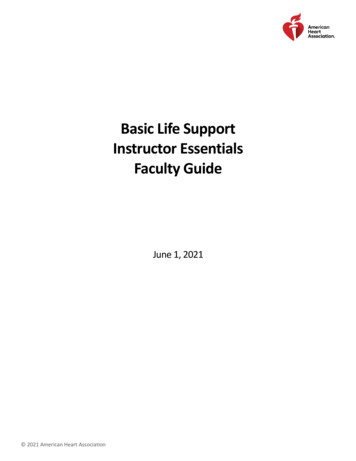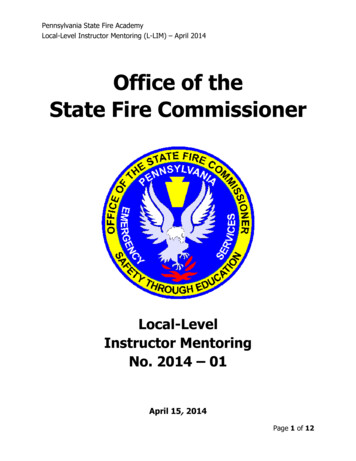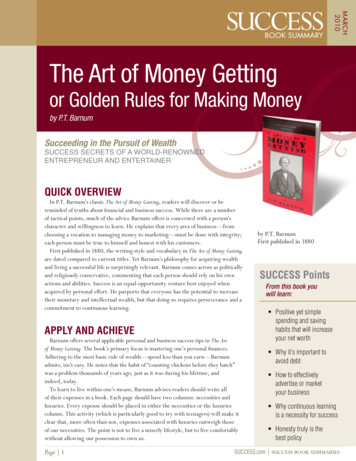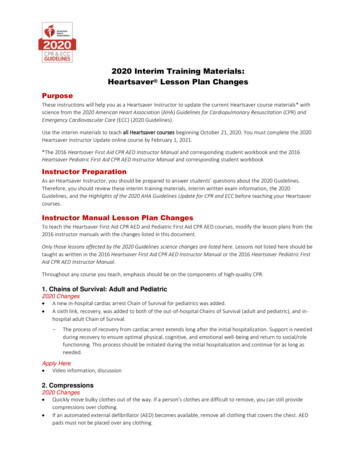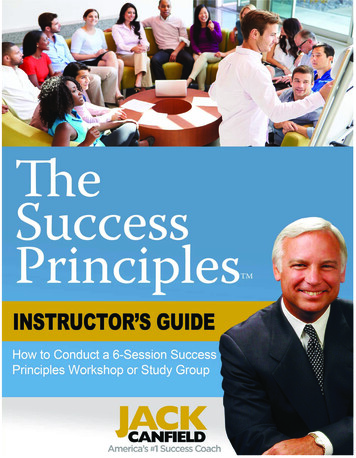
Transcription
Instructor’s ManualFor Conducting a Success Principles Study Group or Workshop
The Success PrinciplesShort Course Instructor’s Manualby Jack CanfieldThis guide is a companion publication to the New York Times Bestselling Book:The Success Principles How to Get From Where You Are to Where You Want to BeBy Jack Canfield with Janet SwitzerHarperResources, 2005This instructor’s manual is a publication ofThe Canfield Training GroupP.O. Box 30880 Santa Barbara, CA 93130 (805) 563-2935 (805) 563-2945For additional resources and updated reader’s information, visit www.thesuccessprinciples.com
Copyright 2015 by Jack Canfield and Self-Esteem Seminars. World rights reserved.The Success Principles is a trademark of Self-Esteem Seminars.This leader’s manual may be reproduced for non-profit use to provide training in the application of theprinciples and strategies for success contained in the book The Success Principles: How to Get fromWhere You Are to Where You Want to Be by Jack Canfield with Janet Switzer in homes, churches, schools,businesses, non-profit organizations and professional associations without written permission from the authorand copyright holder.No part of this publication my be reproduced, transmitted, stored in a retrieval system or translated into anylanguage or computer language, in any form or by any means, electronic, mechanical, magnetic, optical,chemical, manual or otherwise for profit without prior written permission from:Jack Canfield / The Canfield Training GroupP.O. Box 30880, Santa Barbara, CA 93130 (805) 563-2935info4jack@jackcanfield.comThis course is meant to help people integrate and apply the principles and strategies of success presentedin The Success Principles: How to Get from Where You Are to Where You Want to Be by Jack Canfieldwith Janet Switzer (New York: Harper Collins, 2015). The book is available at all bookstores and on theInternet at Amazon.com, BarnesandNoble.com and other online booksellers.This leader’s guide has been written, compiled, typed, edited and formatted by Jack Canfield, JesseIaniello, Kacie Mutschuller and Janet Switzer.
Session 1:Getting StartedAsk participants to read Chapters 1, and 3 of The Success Principlesbefore the session. Make sure you read and understand them aswell.Chapter 1: Take 100% Responsibility for Your LifeE R OChapter 3: Decide What You WantVisionYou can work with any size group. If the group is larger thaneight people, I suggest you break the group into smaller groups of4 members each within the same room. Adjust as necessary to fityour situation. Have the groups sit in circles.Make sure everyone has a pad of paper and a pen or pencil.Suggest that they purchase a journal or notebook especially fortheir notes in this class. Ask that they bring it to each class, sothat they can refer back to what they have written in later classes.Say to the group: “We are going to start by having eachmember introduce yourself, what you do for a living (what yourjob in the company is, etc.), and something you are proud of havingaccomplished.”Make sure every member has access to a copy of The SuccessPrinciples. Ask how many people have read chapters 1, 3 and 7.Tell them not to worry if they haven’t read the chapters. Ask themto read them, plus chapter 10: Release the Brakes and chapter 11:See What You Want, Get What You See before the next sessionRemind them of the formula E R O(Event Response Outcome)most people do is when they don’t get the outcome they want,they blame the event. When they blame the event for not havingwhat they want, it puts all of the power outside of them. There isnothing you can do about external events. What is just is. Sowhat you have to do is change your response to get the outcomeyou want. So 2 2 4. If you don’t like 4, the 2 of the event isa given. You’ve got to change your response from a 2 to someother number, say 3 or 4 or 5, in order to get a different result. Sothe basic principle is getting yourself out of blaming andcomplaining and into taking responsibility.Another important concept is that people tend to complain tothe wrong person. If I’m upset at Patty, I tell Veronica. And if I’mupset at Veronica, I tell Patty. That doesn’t solve anything. I needto tell Veronica if I’m upset at her or Patty if I’m upset at her-sothat the person who can do something about it has the feedbackthat I would like something different. That person doesn’t need togrant my request, but at least I need to communicate a request inorder to get what I want.Another important concept in taking responsibility and notbeing a victim in life is something called a yellow alert. Yellowalerts are things that you notice in your life that act as clues thatthings are happening or about to happen that aren’t going to workout. Like, I hire Sarah and she says, “Oh yeah, I’m thinking aboutmarrying some guy who lives in the Bahamas, and we ignorethat. On another day she says she really is falling more in lovewith the guy and she hates the rainy weather in here in Seattle.And then all of a sudden she quits and we’re surprised and leftunprepared because we weren’t paying attention to the yellowalerts she was giving us all along. There are lots of yellow alerts inyour life — like your husband comes home with lipstick on hiscollar or he’s late every night and you wonder well what’s goingon here? Well I don’t want to say anything about it because thatwould be too uncomfortable. Because it is inconvenient oruncomfortable, we tend to deny the yellow alerts rather than toact on them. So we almost always have clues that things are comingand so we’re not the victims.Tell them: “We are going to work on taking more responsibilityfor our lives, which is the first and most important step towardcreating more success in our lives.”OPTIONAL INTRODUCTORY TALK:If you want, you can read or paraphrase the followingintroduction to responsibility.The key principles we are covering here today are 1) youhave to give up blaming and complaining. We spend most of ourtime blaming things outside of us-the weather, our boss, the trafficthat made us late, the economy, or the current president. Whateverit is, we tend to blame something outside of ourselves. 2) Thesecond thing is that you have to give up all your excuses and takethe position that whatever you’re experiencing in life, the resultsyou are creating (whether it’s physical, financial, or relational),the quality of life you are experiencing is a result of how you areresponding to the events rather than the events themselves. Theformula that captures this is E R O. You might want to writethat down.E R O stands for Event Response Outcome. And whatSo with that in mind we are going to do an exercise.Exercise:Ask the group to get into groups of 4 or 5 or 6 (whatever isappropriate for the size group you are working with). Larger than6 will take up too much time.It’s best to have the following sentence already printed out ona flip chart, poster, PowerPoint slide, white board or chalkboard:If I were to take just 10% more responsibilityfor my life I would.Ask them to go around the group in order, from right to left,completing the following sentence:If I were to take just 10% moreresponsibility for my life I would.Tell them that they are to keep going around the group, takingas many turns as time allows, completing the sentence. Tell themthat you will give them about 4 minutes for the exercise.page 4
Here are several more sentence completion they can do. Youcan do more or less depending on the amount of time you haveallotted for the group session.You can also write these questions on a white board, flip chartor PowerPoint presentation.If I were to take just 10% more responsibility formy happiness, I would.Once they have written down the questions, ask Partner B toask Partner A the questions.If I were to take just 10% more responsibility formy health and fitness, I would.Instruct the people asking the questions not to interrupt, makecomments or give advice. They are simply to ask the questionsand listen to the responses. They start by asking the first question,and then let their partner answer it. When they are finished, theyare to ask the second question and so on until they complete alleight questions.If I were to take just 10% more responsibility forthe quality of my relationships, I would.If I were to take just 10% more responsibility formy effectiveness at work, I would.If I were to take just 10% more responsibility formy happiness, I would.Tell them:“I am going to give you six minutes each to complete theprocess and then you will switch roles, with Partner A askingthe questions and Partner B answering the questions. Ifyou get through the all eight questions before I tell you tostop and switch, go through the questions a second timewith another area of your life that is not working as well asyou would like it to.”At the completion of the exercise (completing several differentsentence stems), say:“Now look at what you’ve said and what you’ve heardfrom all of us and think about two things. First, does anyonesee any common themes? (Participants respond.) And,second, based on that, what’s one action you would bewilling to commit to taking before our next session thatwill put into action any one of those things that you cameup with?It is a good idea to illustrate the process by asking one of theparticipants to ask you the questions. It is helpful, but not necessary,to think about the answers in advance of the demonstration.It doesn’t have to be a huge gargantuan thing, it can be taking30 minutes in your room by yourself because you said “I wantmore time for me” or whatever. Write it down so you capture it,and then let’s go around the group and say it out loud so you hearyourself committing to it - so we can hold ourselves accountable,and so that when we come back tomorrow, we can ask ourselves,“Did I do that?” Because what we are finding really makes thedifference is not what we know . . . but what we do.”Second Exercise:Example:1. What is an area of your life that is not working as well as youwould like it to?I am not getting as much exercise as I would like to, andas a result, I am having difficulty maintaining my idealbody weight of 185 pounds.2. How are you creating or allowing this to happen?Ask the group to break into pairs. If there is an uneven number,you can be that person’s partner after you have given theinstructions. Ask the partners to decide who will be partner A andwho will be partner B.I am staying up too late at night reading or watchingtelevision, so that I don’t feel like getting up early in themorning to exercise before work. I think I will exerciseafter work, but I am usually late getting home from work,so it is not happening.Either ask the group to write down the following eightquestions or prepare the questions on a handout prior to the session:1. What is an area of your life that is not working as well as youwould like it to?3. What are you doing that is not working that you need to doless of?2. How are you creating or allowing this to happen?3. What are you doing that is not working that you need to do lessof?4. What are you currently doing that is working that you could todo more of?I am watching too much television. I am agreeing to toomany projects so that I don’t have enough free time.4. What are you currently doing that is working that you need todo more of?5. What are you not doing that you could try on to see if it works?6. What will you commit to doing as a result of this exercise?7. By when will you do it?8. Write it down.page 5I am delegating more and that is creating more time forme to get my most important work done. I am alsostretching and doing push-ups when I first get up. I amdoing a little yoga before I go to bed.
5. What are you not doing that you could try on to see if it works?I could make a commitment to meet someone for a fastwalk or a run for half an hour four days a week. That wayI wouldn’t back out because I know I would have someonewaiting for me. It would be harder to cop out. I could givemyself some kind of a reward for achieving my goal.Decide What You WantTell them: “The next section of this workshop is working withthe second success principle, which is Deciding What You Want.What we are going to do is work on seven categories of your lifeand decide what it is you want to create or experience in each ofthose categories, and think about it in terms of the next twelvemonths as the time frame you are working with. If we were sittinghere a year from now, what would you like to have happened ineach of those categories? I am going to suggest you come up withthree things for each category.”6. What will you commit to doing as a result of this exercise?I will go to be one half hour earlier. I will go over my inbox with my assistant to assure that I handle things rightaway and delegate more to her. I will set up appointmentsto exercise with my wife and my son four days a week.Ask the participants to turn to a blank page in their notebookor notepad and label the top of a page: “What I Want”Ask them to write down three things they would like to achievein the next year in the following seven areas of their life:7. When will you do it by?I will complete all of these by tomorrow.1. Financial2. Career8. Write it down.3. Recreation and free time(Write down your commitment.)4. Physical fitness and healthSay: “Please face your partner. Remember, no interrupting,asking questions or giving advice. Please begin by partner B askingthe first question.”Give the group 6 minutes, and then ask them to switch roles.(Use a stopwatch if possible; otherwise, it is very easy to losetrack of the accurate amount of time that has elapsed.).When both partners have finished their turns (12 minutes),ask the group to stop and face the front of the room. Ask if anyonewants to share what they learned or what they have committedto.5. Relationships with family and friends6. Personal goals (learning, spiritual growth, personalachievements)7. Community service, contribution, legacyYou can refer to The Vision Exercise on pages 32 and 33 ofThe Success Principles for more details about each of these areasof their lives.Another option is to print copies of the enclosed What I Wantform that appears on the next page:page 6
What I WantWrite down three (3) things you would like to achieve over the next year in the following seven areas of your life:1. Financial2. Career3. Recreation and Free Time4. Physical Fitness & Health5. Relationships With Family & Friends6. Personal Goals(learning, spiritual growth, personal achievements)7. Community Service, Contribution & Legacy 2015 Jack Canfield and Self-Esteem Seminars. This worksheet has been provided as part of The Success Principles Workshop by Jack Canfield and is based upon the New York Times bestselling bookThe Success Principles: How to Get From Where You Are to Where You Want to Be by Jack Canfield with Janet Switzer. For more information, visit www.thesuccessprinciples.com. The Success Principlesis available in all major bookstores and on the Internet at Amazon.com, BarnesAndNoble.com and other online booksellers. The Success Principles is a trademark of Self-Esteem Seminars.page 7
Homework:When they are finished, say:Get back together with your partner from the previousexercise and I will give you two minutes each to just tellyour partner what you wrote down. And then we are goingto come back together and I’m going to give you ahomework assignment and you’ll be done.1) Take action on the things that you wrote down that you aregoing to do as a result of doing the exercises today. Be preparedto report on one of them at our next session.2) Take your goals and begin to think about making them specific- how much by when. Think about how you would quantifythe goal.Okay, partner A begin.Two minutes elapse.Okay, stop. (Pause and make sure you have everyone’sattention.)And now it is partner B’s turn. Go ahead and begin.Two minutes elapse.Okay, stop. Thank your partner for being there for you andturn your attention back to me.3) Read:Chapter 7: Unleash the Power of Goal SettingChapter 10: Release the Brakes andChapter 11: See What You Want, Get What You SeeReminder:Remind them to read their list every day when they first wakeup and before they go to bed at night.page 8
Session 2:Unleash the Powerof Goal Setting &Release the BrakesSupplies:1. Pre-printed list of the guidelines and their annotations frompages 75-77 of The Success Principles (1 per person)2. 3"x5" index cards (about 25 per person)New and Good(Always start every session with this exercise. It sets the tone,builds self-esteem and quickly bonds the group.)Say:“We are going to start by going around the circle and sharesomething that either showed up as a result, or somethingthat you did or an insight that you had as a result of thework we did the last session.”You should go first and then go around the circle from right to left.(Remember to break into smaller groups if your group is morethan 6 or 8 people.Report on Goals You Set for YourselfGo around the group one more time and ask each person to reporton what action they took to accomplish one of their goals sincethe last session.Introductory Lecture“The first thing we are going to do is set measurable goalsfor the 21 things you committed to in the last session. Foreach one, write down your goal in a way that is measurable,so that if someone outside were observing you, they wouldknow you had accomplished the goal.”Use examples from page 52 of the book. The differencebetween a good idea and a goal.“I would like to own a nice home on the ocean someday,”is a desire, but it is not yet stated as a goal, which includeshow much and by when. Here is the same statement statedas a goal. “I will own a 4000 square foot house on PacificCoast Highway in Malibu, California, by noon, April 30,2007.”Bonus Idea:“I’ll share a quick idea with you, it’s called MTO, Minimum .Target . Outrageous. Whenever you set a goal, set a minimumgoal, such as read for five minutes with Josh. My target goal wouldbe twenty minutes. My outrageous goal would be 35 or 40 minutes.Another example is your minimum goal might be to have a tinywine cooler in your kitchen. Your target goal would be to have afull sized wine refrigerator, and your outrageous goal might be tohave a complete wine cellar.Let’s look at cleaning out your garage as an example. Yourminimum goal would be taking out one tire to the curb, your targetgoal might be to take three boxes this weekend and open them upsee what’s in there and decide if you’re going to keep them orthrow them away. Your outrageous goal would be to empty outyour entire garage, paint it, put hire California Closets to installshelving and cabinets, and then take each item - one at a time and put it back only if you want to keep it.The outrageous goal is something that would just blow yourmind if you achieved it. Something that feels like “Well we couldnever do that. We’d never have one thousand people enrolled in aseminar. That would be outrageous.” The target goal is “We coulddefinitely get 400 people enrolled in the seminar.” And theminimum would be 100 people enrolled in the seminar.”So you’re almost guaranteed to reach your minimum. Andyour minimum gets you off the dime because you don’t feel likeyou can’t do it. Your target is within your capabilities. And thenyou have your outrageous. You see, what happens is that mostpeople will start with the minimum, and then they get motivated.Have you ever had the experience where you say, “I’m just goingto clean up the kitchen a little,” and the next thing you knowyou’ve cleaned the entire kitchen, even waxed the floor? It wasjust a matter of getting started. You know what I mean; you werejust going to go down town for a minute then you spend threehours down there getting errands done.Then ask yourself, “Who could I delegate part or all of thistoo?” You could delegate the entire garage to California Closetsand your wife and twenty-year-old son. You wouldn’t have to beinvolved with it at all, and it still gets done. So sometimes youdelegate it to someone you know. Or you trade by doing somethingyou like to do for them, and they do this for you. And if you havemoney, you’ll find that you can buy solutions to most of yourproblems, thus freeing up valuable time to create and enjoy thelife you want.Creating AffirmationsSay:“For every goal you have, you want to have an affirmationthat affirms having that goal in the present tense.”Instruct the participants to: “Go ahead and take the time tolist each goal with a how much and a date of completion.”page 9
Handout the Guidelines for Creating an Affirmation:feeling alive at 135" or “I’m feeling fine at 139.” You can havefun with these. The unconscious responds to emotion and humor.Say:Number eight is, “Make them for yourself, not others.”“I am going to go over the nine guidelines for creating anaffirmation. The purpose of an affirmation is that you aregoing to declare something as if it was already true but it’snot manifested in reality yet. What that does is create inthe brain a dynamic tension that results in motivation. Allmotivation comes from having a picture of something thatyou want in your head that you have not yet created inreality. The purpose of an affirmation is to create andmaintain this tension to create motivation. “Number nine is, “Add the words ‘or something better’”.When you add the words “or something better” it opens upopportunity.Say:“We are going to take the next 10 minutes to write someaffirmations. You eventually want to write one affirmationfor each goal that you have. So what I would like you to dothen is refer back to some of the goals you set earlier, and Iwould like you to spend 10 minutes writing affirmations.Write an affirmation for each of your goals.”Review the 9 guidelines for creating effective affirmations (Seepages 75-77)1. Start with the words I am.Let me walk one person through it.2. Use the present tense3. State it in the positive. Affirm what you want, not what youdon’t want.4. Keep it brief.5. Make it specific.6. Include an action word ending in with -ing.Goal: To not just spend money on little things, to save it to getsomething bigger instead (a new wine refrigerator, for example).Affirmation: “I am feeling happy stocking my new winerefrigerator with 40 bottles of wine.”Option: Give everyone 21 3x5 index cards and have themwrite one affirmation per card.7. Include at least one dynamic emotion or feeling word.8. Make affirmations for yourself, not others.9. Add the words or something better.When they are complete, have the group break into pairs andread some of their affirmations to each other, checking to see ifthey meet all 9 guidelines. If not, correct them until they do.So the first guideline is:“Your affirmation needs to start with the words ‘I am.’” Forexample, “I am driving my new Porsche Carrera down State Street.”Release the Brakes with VisualizationSay:The second one is, “Use the present tense.”You never say I am going to. Always use the present.“What you want to do every day is read through youraffirmations at least two times - once in the morning whenyou first get up and then again at night before you retire.To get the most power out of your goals andaffirmations.stop after each affirmation, close your eyesand see the goal as it would look if you had already achievedit.”The third is, “State it in the positive.”By that I mean, affirm what you want, not what you don’twant.Number four is “Keep it brief.”Imagine that every word in your affirmation costs onethousand dollars and you could pull out two words and you couldsave 2000 dollars, what would you pull out?Number five is, “Make it specific.”Read to the group: the six points covered under the sectionentitles “How to Use Affirmations and Visualization” on page 78of The Success Principles.Say:Number six, include an action word that ends in -ing.For example: I am driving, I am celebrating, I am living.Number seven is “Include at least one dynamic feelingword.”For example: ecstatically, joyfully, proudly.The reason wewant things is because of the way we think they are going tomake us feel.You wouldn’t say, “I am remodeling my house.” You wouldsay, “I’m celebrating my newly remodeled house.”You wouldn’t say, “I’m losing weight;.” You would say, “I’mpage 10“So here’s the next piece of this: What you want to doevery day, the discipline that grows out of this, is to putyour affirmations into some kind of format so you’ll beable to easily read them every morning and every nightbefore you go to bed.So that can be one affirmation each on a 3 by 5 index card,or it could be typed up really nicely and laminated or putinto a page protector.
Some people tape them to their refrigerator. You could putthem as a pop-up screen on your computer. The idea isyou want to keep them constantly in your face because thebiggest problem is that people don’t stay focused on whatit is they want to create. They become reactive rather thanproactive.about thirty minutes with his list of affirmations, literally runningaround the house screaming, jumping up and down, and gettingreally emotional about it. He claims it is one of his crucial disciplinesof success.If you remember the tragedy of 9/11, most of you rememberexactly what happened, where you were, who you were with,what you were wearing, what was going on, and what you did forthe next several hours. The reason you do is because when youhave high emotion attached to a memory, you’ll remember thatforever because your brain actually secretes more proteins whenyou experience strong emotions, which actually supports thegrowth of more dendrite spiny protuberances at the ends of theneurons of your brain, which strengthens the neuronal pathwaysfor those memories to re-emerge. John’s students, businessmenand women who he is teaching these techniques to, are all doublingand tripling their income within several months. So the way youre-program your brain for success is to repeat your affirmationsalong with the visualization and emotion. So I would encourageyou to add the emotional component. And remember, this needsto be a daily practice to reprogram your self for success.So basically this process of reading through youraffirmations every day brings them to the forefront of yourconsciousness. Then the next step we’re going to take is toread your affirmation, and then you close your eyes andthen visualize the result. Because right now, you have animage of what it looks like to go to the gym, but you maynot have an image of what your new house looks like, soyou need to create that. The one for losing weight, youmight have a picture of you at that weight you want to be,or fitting into a size 8 dress, or completing a half marathon,or you might just want to imagine looking at the scale andseeing 125 or 140 or 165, whatever your ideal weight is,showing on the scale.ExerciseHomework:So let’s do this: On the count of three, I’d like you to readyour first affirmation out loud. (My experience is that if you readit out loud, it has more affect. Try to read it with the same level ofenergy it expresses. You wouldn’t say (read it sadly) “I’m feelingreally ecstatic and powerful.” You also wouldn’t say (read itexcitedly) “I’m feeling peaceful reading my book!!!” Try to matchthe quality of the energy of the affirmation because when you cangenerate the feeling you want to have as a result of achieving thegoal that the affirmation represents, you activate the law ofattraction. Remember, like attracts like.Okay, so on the count of three, read the first one out loudwith emotion: 1.2.3. go.Okay, now close your eyes and create a picture of what itwould look like if you had already achieved that.Okay, look at your second affirmation, and on the count ofthree, say it out loud.Okay, now close your eyes and create a picture of what itwould look like if you had already achieved that one.Okay, one more out loud.Okay, now close your eyes and create a picture of what itwould look like if you had already achieved that one.Okay, let’s do one last one out loud.1. The homework is to put these in a forum where you can usethe. The more energy you put into this the better. There isanother option here that some people use. They take 5 by 7index cards and write their affirmation on one side and putimages that represent the fulfillment of that affirmation on theother side. For example you could have a picture of a personrunning or of a person at a certain weight etc. So take theaffirmations put them in some format, type them up, laminatethem, do whatever you want to do with them.2. Make sure you say your affirmations with emotion at leasttwice a day.3. Keep taking action on your goals. I’ll expect you to report onone of them at the next session.4. In the next session we are going to be making Vision Boardsor what some people call Dream Boards or Treasure Maps. Thesewill be a collage on poster board of images that represent thefulfillment of all of your goals. I want you to bring in picturesof images that you have cut from magazines, brochures, andso forth to use on your Vision Boards. Also bring in somemagazines that contain lots of pictures and words that otherpeople in the group can use as well. The more different kindsof magazines - mainstream, sports, luxury, vacation, multiethnic, bride, real estate, women’s and men’s magazines - thebetter. Also bring a pair of scissors and a glue stick (unless youare providing). I’ll provide the poster board. ( 22"x28.5" posterboard is ideal.)Okay, now close your eyes and create a picture of what itwould look like if you had already achieved that.Jack Canfield, the co-author of The Success Principles tellsabout a friend of his by the name of John Assaraf, who is also theauthor of a book called The Street Kid’s Guide to Having it All.He makes several million dollars a year. Every morning he spend
Jack Canfield / The Canfield Training Group P.O. Box 30880, Santa Barbara, CA 93130 (805) 563-2935 info4jack@jackcanfield.com This course is meant to help people integrate and apply the principles and strategies of success presented in The Success Principles: How to Get from Where You Are

